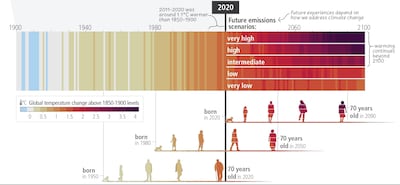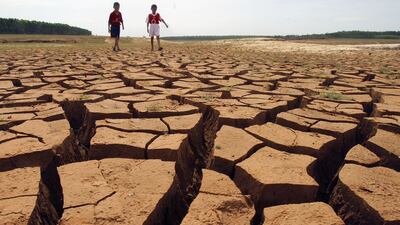The main goal of Cop29 in Baku, Azerbaijan, was to keep the global temperature increase to no more than 1.5°C above pre-industrial levels. If this is not achieved, experts warn it could signal the difference between extinction and survival for some communities.
While a dystopian future akin to Kevin Costner’s Waterworld or Mel Gibson’s Mad Max films may not be immediately on the horizon, scientists say that glimpses of what is to come have already been experienced in not only the increase in the number of natural disasters, but in the severity of disasters taking place around the globe.
In the UAE, for example, scientists say the floods that affected Dubai in April this year were exacerbated by climate change.
In the US, according to the National Centres for Environmental Information, there have been 24 confirmed climate disaster events with losses exceeding $1 billion each this year. That is almost three times the average number of 8.5 events from 1980 to 2023.
This year is on track to be the hottest on record and, in its latest climate statement, the World Meteorological Organisation issued a red alert to highlight that 2015-2024 will be the warmest 10 years in history.
The UN has also warned that if new nationally determined plans are not ambitious enough to rein in greenhouse gas emissions, and if measures are not immediately implemented, the world is on track for a temperature increase of 2.6°C to 3.1°C.
Although negotiations were complex and far-reaching at what has been dubbed the finance Cop, the Paris Agreement – the target agreed upon by 196 parties at Cop21 in Paris in 2015 – still loomed large.
The UN says annual greenhouse gas emission reductions of 42 per cent are needed by 2030 and 57 per cent by 2035 to get on track to 1.5°C. However, on the sidelines of Cop29, new research was published by the Global Carbon Project’s science team showing global carbon emissions from fossil fuels reached a record high in 2024.
Catastrophic consequences
Dr Susana Hancock is the global mountains director at International Cryosphere Climate Initiative, a platform that works to elevate the voices of scientists and local communities from Arctic and mountain regions to reach governments, non-profits, and international forums.
Cryosphere refers to ice, snow and permafrost regions, as well as both polar oceans. Dr Hancock told The National that these areas are going to be lost due to global warming and – while what is happening up in the mountains may seem distant – what happens in the cryosphere does not stay in the cryosphere, and reaches communities and ecosystems around the planet.
She said: “1.5°C really needs to be a hard limit, and it's not an arbitrary number. It is based on science, and what we're seeing in the Arctic and the cryosphere. The glaciated cold regions of the world, mountains, and the Himalayas, the Andes, the Alps, 1.5°C isn't safe. And certainly anything higher that is really not safe.”
By the end of the century, she said, glaciers could lose as much as 80 per cent of volume on the current trajectory – and if the needle is moved from 1.5°C to 2.5°C, the results would be catastrophic.
“We're seeing situations that are getting increasingly dire, and really feel that 2°C, is not a safe environment for this part of the world,” said Dr Hancock.
What does 2°C, 2.5°C, or even 3°C look like?
In a passionate plea earlier this year, UN Secretary General Antonio Guterres said the difference between 1.5°C and 2°C could be the difference between extinction and survival for some small island states and coastal communities.
Developing nations are calling for trillions in climate finance to combat climate chaos. According to the Intergovernmental Panel on Climate Change, developing countries have 15 times more victims of natural disasters than developed nations.
Scientists say further escalation in temperatures will result in the collapse of the Greenland Ice Sheet and the West Antarctic Ice Sheet, followed by catastrophic sea level rises.
In the US alone, almost 30 per cent of the population live in coastal areas, where rising sea levels play a role in flooding, shoreline erosion and hazards from storms. Globally, eight of the world’s 10 largest cities are near a coast, according to the UN Atlas of the Oceans.
According to the latest IPCC Synthesis Report, with every increment of global warming, regional changes in the average global climate and extremes become more widespread and pronounced.
“Almost half of the world’s population lives in regions that are highly vulnerable to climate change,” said Aditi Mukherji, one of the 93 authors of IPCC Synthesis Report. “In the last decade, deaths from floods, droughts and storms were 15 times higher in highly vulnerable regions.”
Further temperature increases would mean a rise in inland and coastal flooding. More displacement of citizens around the globe will also affect physical water availability and agricultural production.
“Communities which tend to live in river valleys due to irrigation and agriculture don't have alerts that there's a flood coming, and it can wipe out an entire village. That's an example of something that we're going to be seeing increasingly over the coming years and decades,” Dr Hancock said.
Killing of Qassem Suleimani
The%20specs
%3Cp%3E%3Cstrong%3EEngine%3A%3C%2Fstrong%3E%201.8-litre%204-cyl%20turbo%0D%3Cbr%3E%3Cstrong%3EPower%3A%20%3C%2Fstrong%3E190hp%20at%205%2C200rpm%0D%3Cbr%3E%3Cstrong%3ETorque%3A%3C%2Fstrong%3E%20320Nm%20from%201%2C800-5%2C000rpm%0D%3Cbr%3E%3Cstrong%3ETransmission%3A%20%3C%2Fstrong%3ESeven-speed%20dual-clutch%20auto%0D%3Cbr%3E%3Cstrong%3EFuel%20consumption%3A%3C%2Fstrong%3E%206.7L%2F100km%0D%3Cbr%3E%3Cstrong%3EPrice%3A%3C%2Fstrong%3E%20From%20Dh111%2C195%0D%3Cbr%3E%3Cstrong%3EOn%20sale%3A%20%3C%2Fstrong%3ENow%3C%2Fp%3E%0A
The specs
Engine: Direct injection 4-cylinder 1.4-litre
Power: 150hp
Torque: 250Nm
Price: From Dh139,000
On sale: Now
LA LIGA FIXTURES
Friday Valladolid v Osasuna (Kick-off midnight UAE)
Saturday Valencia v Athletic Bilbao (5pm), Getafe v Sevilla (7.15pm), Huesca v Alaves (9.30pm), Real Madrid v Atletico Madrid (midnight)
Sunday Real Sociedad v Eibar (5pm), Real Betis v Villarreal (7.15pm), Elche v Granada (9.30pm), Barcelona v Levante (midnight)
Monday Celta Vigo v Cadiz (midnight)
RESULTS
1.30pm Handicap (PA) Dh 50,000 (Dirt) 1,400m
Winner AF Almomayaz, Hugo Lebouc (jockey), Ali Rashid Al Raihe (trainer)
2pm Handicap (TB) Dh 84,000 (D) 1,400m
Winner Karaginsky, Tadhg O’Shea, Satish Seemar.
2.30pm Maiden (TB) Dh 60,000 (D) 1,200m
Winner Sadeedd, Ryan Curatolo, Nicholas Bachalard.
3pm Conditions (TB) Dh 100,000 (D) 1,950m
Winner Blue Sovereign, Clement Lecoeuvre, Erwan Charpy.
3.30pm Handicap (TB) Dh 76,000 (D) 1,800m
Winner Tailor’s Row, Royston Ffrench, Salem bin Ghadayer.
4pm Maiden (TB) Dh 60,000 (D) 1,600m
Winner Bladesmith, Tadhg O’Shea, Satish Seemar.
4.30pm Handicap (TB) Dh 68,000 (D) 1,000m
Winner Shanaghai City, Fabrice Veron, Rashed Bouresly.
UAE currency: the story behind the money in your pockets
The biog
From: Ras Al Khaimah
Age: 50
Profession: Electronic engineer, worked with Etisalat for the past 20 years
Hobbies: 'Anything that involves exploration, hunting, fishing, mountaineering, the sea, hiking, scuba diving, and adventure sports'
Favourite quote: 'Life is so simple, enjoy it'
The specs: 2018 Audi R8 V10 RWS
Price: base / as tested: From Dh632,225
Engine: 5.2-litre V10
Gearbox: Seven-speed automatic
Power: 540hp @ 8,250rpm
Torque: 540Nm @ 6,500rpm
Fuel economy, combined: 12.4L / 100km
INDIA'S%20TOP%20INFLUENCERS
%3Cp%3E%3Cstrong%3EBhuvan%20Bam%3C%2Fstrong%3E%3Cbr%3E%3Ca%20href%3D%22https%3A%2F%2Fwww.instagram.com%2Fbhuvan.bam22%2F%3Fhl%3Den%22%20target%3D%22_self%22%3EInstagram%3C%2Fa%3E%20followers%3A%2016.1%20million%3Cbr%3EBhuvan%20Bam%20is%20a%2029-year-old%20comedian%20and%20actor%20from%20Delhi%2C%20who%20started%20out%20with%20YouTube%20channel%2C%20%E2%80%9CBB%20Ki%20Vines%E2%80%9D%20in%202015%2C%20which%20propelled%20the%20social%20media%20star%20into%20the%20limelight%20and%20made%20him%20sought-after%20among%20brands.%3Cbr%3E%3Cstrong%3EKusha%20Kapila%3C%2Fstrong%3E%3Cbr%3E%3Ca%20href%3D%22https%3A%2F%2Fwww.instagram.com%2Fkushakapila%2F%3Fhl%3Den%22%20target%3D%22_self%22%3EInstagram%3C%2Fa%3E%20followers%3A%203.1%20million%3Cbr%3EKusha%20Kapila%20is%20a%20fashion%20editor%20and%20actress%2C%20who%20has%20collaborated%20with%20brands%20including%20Google.%20She%20focuses%20on%20sharing%20light-hearted%20content%20and%20insights%20into%20her%20life%20as%20a%20rising%20celebrity.%3Cbr%3E%3Cstrong%3EDiipa%20Khosla%3C%2Fstrong%3E%3Cbr%3E%3Ca%20href%3D%22https%3A%2F%2Fwww.instagram.com%2Fdiipakhosla%2F%3Fhl%3Den%22%20target%3D%22_self%22%3EInstagram%3C%2Fa%3E%20followers%3A%201.8%20million%3Cbr%3EDiipa%20Khosla%20started%20out%20as%20a%20social%20media%20manager%20before%20branching%20out%20to%20become%20one%20of%20India's%20biggest%20fashion%20influencers%2C%20with%20collaborations%20including%20MAC%20Cosmetics.%3Cbr%3E%3Cstrong%3EKomal%20Pandey%3Cbr%3E%3C%2Fstrong%3E%3Ca%20href%3D%22https%3A%2F%2Fwww.instagram.com%2Fkomalpandeyofficial%2F%3Fhl%3Den%22%20target%3D%22_self%22%3EInstagram%3C%2Fa%3E%20followers%3A%201.8%20million%3Cbr%3EKomal%20Pandey%20is%20a%20fashion%20influencer%20who%20has%20partnered%20with%20more%20than%20100%20brands%2C%20including%20Olay%20and%20smartphone%20brand%20Vivo%20India.%3Cbr%3E%3Cstrong%3ENikhil%20Sharma%3C%2Fstrong%3E%3Cbr%3E%3Ca%20href%3D%22https%3A%2F%2Fwww.instagram.com%2Fnikkkhil%2F%3Fhl%3Den%22%20target%3D%22_self%22%3EInstagram%3C%2Fa%3E%20followers%3A%201.4%20million%3Cbr%3ENikhil%20Sharma%20from%20Mumbai%20began%20his%20online%20career%20through%20vlogs%20about%20his%20motorcycle%20trips.%20He%20has%20become%20a%20lifestyle%20influencer%20and%20has%20created%20his%20own%20clothing%20line.%3Cbr%3E%3Cem%3ESource%3A%20Hireinfluence%2C%20various%3C%2Fem%3E%3Cbr%3E%3C%2Fp%3E%0A
Europe’s rearming plan
- Suspend strict budget rules to allow member countries to step up defence spending
- Create new "instrument" providing €150 billion of loans to member countries for defence investment
- Use the existing EU budget to direct more funds towards defence-related investment
- Engage the bloc's European Investment Bank to drop limits on lending to defence firms
- Create a savings and investments union to help companies access capital
COMPANY%20PROFILE
%3Cp%3E%3Cstrong%3EName%3A%20%3C%2Fstrong%3EQureos%0D%3Cbr%3E%3Cstrong%3EBased%3A%20%3C%2Fstrong%3EUAE%0D%3Cbr%3E%3Cstrong%3ELaunch%20year%3A%20%3C%2Fstrong%3E2021%0D%3Cbr%3E%3Cstrong%3ENumber%20of%20employees%3A%20%3C%2Fstrong%3E33%0D%3Cbr%3E%3Cstrong%3ESector%3A%20%3C%2Fstrong%3ESoftware%20and%20technology%0D%3Cbr%3E%3Cstrong%3EFunding%3A%20%3C%2Fstrong%3E%243%20million%0D%3Cbr%3E%3C%2Fp%3E%0A
SQUADS
India
Virat Kohli (captain), Rohit Sharma (vice-captain), Shikhar Dhawan, Ajinkya Rahane, Manish Pandey, Kedar Jadhav, Dinesh Karthik, Mahendra Singh Dhoni (wicketkeeper), Hardik Pandya, Axar Patel, Kuldeep Yadav, Yuzvendra Chahal, Jasprit Bumrah, Bhuvneshwar Kumar, Shardul Thakur
New Zealand
Kane Williamson (captain), Martin Guptill, Colin Munro, Ross Taylor, Tom Latham (wicketkeeper), Henry Nicholls, Ish Sodhi, George Worker, Glenn Phillips, Matt Henry, Colin de Grandhomme, Mitchell Santner, Tim Southee, Adam Milne, Trent Boult
KILLING OF QASSEM SULEIMANI
HOSTS
T20 WORLD CUP
2024: US and West Indies; 2026: India and Sri Lanka; 2028: Australia and New Zealand; 2030: England, Ireland and Scotland
ODI WORLD CUP
2027: South Africa, Zimbabwe and Namibia; 2031: India and
Bangladesh
CHAMPIONS TROPHY
2025: Pakistan; 2029: India
Squid Game season two
Director: Hwang Dong-hyuk
Stars: Lee Jung-jae, Wi Ha-joon and Lee Byung-hun
Rating: 4.5/5
FA%20Cup%20semi-final%20draw
%3Cp%3ECoventry%20City%20v%20Manchester%20United%C2%A0%3C%2Fp%3E%0A%3Cp%3EManchester%20City%20v%20Chelsea%3C%2Fp%3E%0A%3Cp%3E-%20Games%20to%20be%20played%20at%20Wembley%20Stadium%20on%20weekend%20of%20April%2020%2F21.%C2%A0%3C%2Fp%3E%0A
UAE currency: the story behind the money in your pockets




